SAF on a flight path to climate effectiveness
Airlines’ largest corporate customers are demanding a transformation to net zero climate impact, and they have learned to do business virtually and remotely, with no flights involved. Aviation’s future demands a fundamental reimagining of this “hard-to-decarbonise sector” to put it on a flight path compatible with climate protection. It will not be easy.
Most industry executives are understandably preoccupied with trying to stay in business.
Airbus aims to launch zero-emission hydrogenpowered aircraft by 2035, but must overcome significant technological hurdles. Carriers are making climate pledges, but few have an ambitious plan.
Existing aircraft could use electrofuels (power-to-liquids), but these require further research and development, not to mention vast supplies of surplus renewable electricity that will only be available in the decades to come. Today, we need to focus on solutions at hand – improving aircraft efficiency, and...










